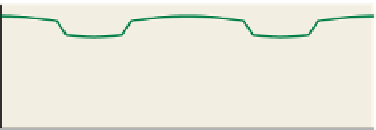Graphics Reference
In-Depth Information
transform looks like the box function
b
. Unfortunately, it's impossible for a func-
tion
f
L
2
(
R
)
to have finite support and have
f
also have finite support [DM85].
But we
can
find finitely supported filters whose transforms are
nearly
zero outside
a small interval, as we'll discuss presently. If we agree to replace sinc by such a
filter, then the whole question of whether the extension of the source image is
L
2
disappears: We can simply extend the source image by an amount
R
that's greater
than the support of the filter, and then fill in with zeroes beyond there. This is
option 4, listed above.
Finally, option 5 presents one last approach that's somewhat unprincipled, but
works well in practice. When we compute the value for a pixel with a summation
of the form
∈
target
(
j
)=
i
source
(
i
)
sinc
(
j
−
i
)
,
(19.7)
we're computing a weighted sum of source pixels. In this particular case, the
weights come from the sinc function, but more generally we're computing some-
thing of the form
target
(
j
)=
i
source
(
i
)
w
(
j
−
i
)
,
(19.8)
where
w
is a list of weights. If these weights don't sum to one, then filtering a
constant
image results in an image whose values are different from that constant.
An example, based on filtering in the horizontal direction with a truncated sinc,
is shown in Figure 19.8. The constant signal is shown in blue; it was sampled at
integer points and reconstructed with
x
3.5.
The resultant function was sampled far more finely and plotted in green, showing
substantial ripple.
Typically, for things like a truncated sinc, the sum
W
of the weights is very
close to one at each pixel. The sum may vary from one pixel to the next, however,
resulting in a ripple when we try to reconstruct a constant image, as the figure
shows. We can fix this problem somewhat by dividing by the sum of the weights
at each pixel, which removes the ripple. In effect, we've altered the filter so that
its Fourier transform is zero at all multiples of the sampling frequency. We've
→
1.4sinc
(
1.4
x
)
, truncated for
|
x
| >
1
0
93
93.2 93.4 93.6 93.8
94
94.2 94.4 94.6 94.8
95
Figure 19.8: Top: Filtering a constant 1D signal with a truncated
sinc
leads to ripple.
Bottom: A gray image, filtered and resampled with the same truncated
sinc
in the horizontal
direction, ends up striped.














